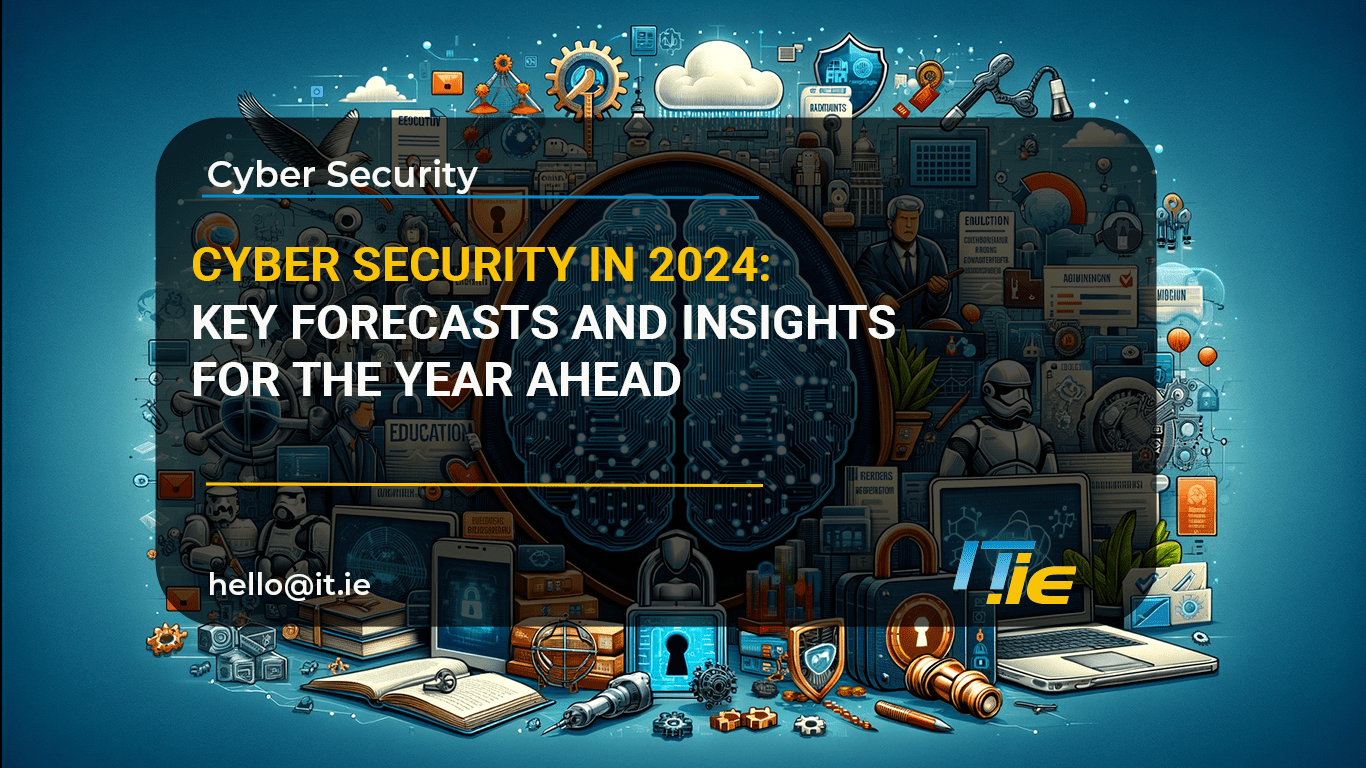As 2024 unfolds, the cyber security landscape is rapidly evolving. Understanding the key trends shaping this dynamic field is essential to keep pace with emerging threats and challenges. In late 2023, leading industry vendors released their predictions and forecasts for the coming year. For this post I decided to test the capabilities of ChatGPT plus in analysing information from multiple sources. I first provided links to each report asking the AI to analyse the reports separately. I then asked it to collate the information into the ten most common themes and trends for 2024. This post presents a synthesis of these insights, offering a glimpse into what 2024 holds for cyber security, with a unique perspective gained through AI-enhanced analysis.
1. The Rise of AI in Cyber Security
One of the most significant trends identified is the increased use of Artificial Intelligence (AI) in cyber security. AI’s role is twofold: enhancing defence mechanisms and powering sophisticated cyberattacks. AI-driven automation in threat detection and incident response is set to become more prevalent, offering efficient solutions to complex security challenges. However, this also means that cybercriminals will leverage AI to craft more convincing phishing campaigns and social engineering attacks, necessitating advanced AI countermeasures.
2. The Persistent Threat of Ransomware
Ransomware continues to be a significant threat, evolving with increasingly sophisticated tactics like double and triple extortion. In double extortion, cybercriminals not only encrypt the victim’s data but also threaten to release sensitive information publicly if the ransom isn’t paid. Triple extortion takes this a step further by adding additional layers of pressure, such as launching DDoS attacks or contacting the victim’s customers or partners to demand ransom. These advanced strategies make attacks more targeted and disruptive, highlighting the critical need for robust backup strategies, comprehensive incident response plans, and ongoing employee awareness training to mitigate these risks.
3. Passwordless Authentication Gains Traction
2024 is expected to witness a significant shift towards passwordless authentication methods. Biometrics, hardware tokens, and passkeys are becoming increasingly popular, driven by the need to enhance security and user experience. This transition aims to reduce reliance on traditional passwords, a common vector for cyberattacks.
4. The Growing Role of Cyber Insurance
As cyber threats escalate, so does the demand for cyber insurance. However, concerns about coverage limitations and exclusions are also rising. Cyber insurance is becoming an integral part of risk management strategies for businesses, highlighting the financial implications of cyber threats. Read our post “Cyber Insurance Checklist: 10 Essential Controls” to better understand the requirements for cyber insurance.
5. Managing AI Deployment and Challenges
The deployment and management of AI in cyber security present unique challenges. There’s a growing concern about AI replacing human roles, emphasising the need for AI to augment rather than replace security teams. Effective management and ethical considerations of AI tools are crucial to harness their full potential.
6. Emphasis on Education and Soft Skills
Insider threats, posed by employees or associates misusing their access to harm an organisation’s systems or data, necessitate improved internal security training. Effective training is crucial for building a strong defence against such risks, educating staff on recognising potential threats and the importance of soft skills like communication and ethics.
7. Zero Trust and Access Management
The adoption of Zero Trust security models is on the rise. This approach, which verifies every user and device before granting access, is increasingly relevant in today’s remote work and cloud-centric environments. Access management is focusing on robust identity verification and controlling access to sensitive data.
8. Navigating Regulatory Changes and Compliance
In response to imminent regulatory changes in Europe, organisations must be vigilant, particularly regarding the EU Data Act and GDPR Procedural Regulation. These reforms, focusing on data protection, breach disclosures, and digital services, necessitate proactive adaptation to ensure compliance, avoid penalties, and maintain consumer trust. Emphasis on clear data sharing rules, stringent enforcement of data privacy, and harmonisation of digital service regulations will be key areas of focus.
9. Geopolitical Tensions Impact Cyber security
Geopolitical tensions significantly influence the cyber security landscape, with an increase in state-sponsored cyber activities. Recent years have seen several instances of cyber espionage and disruptive attacks attributed to nation-states. Notable examples include:
- SolarWinds Hack (2020): A sophisticated supply chain attack, widely attributed to Russian state-sponsored hackers, compromised numerous US government agencies and private sector companies.
- Microsoft Exchange Server Hacks (2021): Attributed to Chinese state-sponsored actors, these attacks targeted tens of thousands of organisations globally, exploiting vulnerabilities in Microsoft Exchange servers.
- NotPetya Attack (2017): One of the most devastating cyberattacks in history, NotPetya was attributed to Russian military hackers and targeted Ukraine, causing widespread global collateral damage.
10. Enhanced Focus on Cloud Security
With the increasing adoption of cloud services, cloud security is becoming a top priority. Organisations are expected to invest more in securing their cloud environments against data breaches, misconfigurations, and unauthorised access. The trend towards multi-cloud and hybrid environments further complicates this, requiring more sophisticated and integrated cloud security solutions. This shift underscores the need for continuous monitoring, robust access controls, and comprehensive security policies tailored to the unique challenges of cloud computing.
Although not listed among the top ten concerns, we can anticipate a rise in election disinformation as the US presidential election campaigns gain momentum. According to Forbes, it is expected that bad actors will employ sophisticated social engineering tactics to manipulate public opinion and undermine the democratic process.
Conclusion
As 2024 progresses, the cyber security landscape is rapidly evolving, marked by advanced threats and innovative defences. The rise of AI in cyber security is a double-edged sword, enhancing protection while also empowering attackers. The escalation of ransomware tactics necessitates stronger security measures and comprehensive employee training.
The shift towards passwordless authentication and the increasing reliance on cyber insurance reflect a broader change in risk management strategies. Navigating regulatory changes and the impact of geopolitical tensions are also key challenges this year.
In summary, 2024 demands a multifaceted approach to cyber security, combining technological advancements with strategic planning and human-centric solutions. Staying informed and adaptable is crucial for organisations to protect against the dynamic cyber threats of today’s world.
Sources
- https://services.google.com/fh/files/misc/google-cloud-cybersecurity-forecast-2024.pdf
- https://documents.trendmicro.com/assets/white_papers/Critical_Scalability-Trend-Micro-Security-Predictions-for-2024.pdf
- https://www.watchguard.com/wgrd-resource-center/cyber-security-predictions-2024
- https://www.techrepublic.com/article/kaspersky-advanced-threat-predictions-2024/
- https://www.fortinet.com/content/dam/maindam/PUBLIC/02_MARKETING/08_Report/report_cyberthreat-predictions-2024.pdf
- https://www.splunk.com/en_us/pdfs/gated/ebooks/security-predictions-2024.pdf
- https://www.sdxcentral.com/articles/analysis/forrester-predicts-2024-will-be-a-year-of-ai-risks-and-regulatory-scrutiny/2023/11/
- https://www.ibm.com/thought-leadership/institute-business-value/en-us/report/business-trends-2024
- https://www.beyondtrust.com/blog/entry/beyondtrust-cybersecurity-trend-predictions
- https://blog.checkpoint.com/artificial-intelligence/into-the-cyber-abyss-check-points-riveting-2024-predictions-reveal-a-storm-of-ai-hacktivism-and-weaponized-deepfakes/
- https://www.proofpoint.com/us/blog/ciso-perspectives/proofpoints-2024-predictions-brace-impact
- https://blogs.idc.com/2023/11/01/top-10-worldwide-it-industry-2024-predictions-mastering-ai-everywhere/
- https://vmblog.com/archive/2023/11/13/delinea-2024-predictions-cyber-in-2024-ai-cyber-insurance-passwordless-and-beyond.aspx
- https://www.zerofox.com/2024-predictions/
- https://www.cobalt.io/blog/cybersecurity-statistics-2024
- https://www.cyberark.com/resources/blog/cybersecurity-predictions-for-2024-and-beyond
- https://www.enterprisesecuritytech.com/post/qualys-2024-cybersecurity-forecast-streamlining-ai-support-and-soft-skill-emphasis
- https://www.nortonlifelock.com/blogs/blog-post/cybersecurity-predictions-2024
- https://research.g2.com/insights/security-trends-2024
- https://www.fticonsulting.com/insights/articles/10-global-cybersecurity-predictions-2024
- https://www.forbes.com/sites/forbestechcouncil/2023/12/26/eight-cybersecurity-trends-to-watch-for-2024/
- https://www.splashtop.com/blog/cybersecurity-trends-and-predictions-2024














